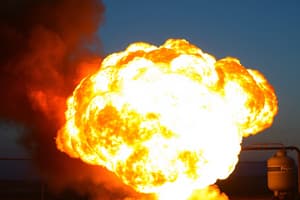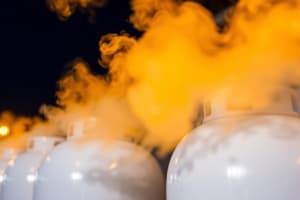Podcast
Questions and Answers
What health hazard rating is assigned to propane gas according to the Fire Diamond classification?
What health hazard rating is assigned to propane gas according to the Fire Diamond classification?
- 1
- 0
- 4
- 2 (correct)
At what temperature does propane gas ignite?
At what temperature does propane gas ignite?
- 1120º F (correct)
- 1020º F
- 820º F
- 920º F (correct)
When responding to a gas leak without fire, how far should the first arriving unit stop from the leak source?
When responding to a gas leak without fire, how far should the first arriving unit stop from the leak source?
- 200 ft
- 100 ft
- 500 ft
- 333 ft (correct)
Which of the following is a key property of propane gas?
Which of the following is a key property of propane gas?
What is the molecular weight of propane gas compared to air?
What is the molecular weight of propane gas compared to air?
What is the lower explosive limit percentage range for propane gas in air?
What is the lower explosive limit percentage range for propane gas in air?
What should be included in the emergency response procedures for propane gas incidents?
What should be included in the emergency response procedures for propane gas incidents?
In what situations should incidents involving propane gas be approached with caution?
In what situations should incidents involving propane gas be approached with caution?
What should be done in the event of a gas leak near an explosion area?
What should be done in the event of a gas leak near an explosion area?
What is the minimum distance that personnel must evacuate from a low explosive limit (LEL) reading?
What is the minimum distance that personnel must evacuate from a low explosive limit (LEL) reading?
What action should be taken if flames are observed coming through the ground?
What action should be taken if flames are observed coming through the ground?
When should a safety perimeter be established and maintained?
When should a safety perimeter be established and maintained?
What is the safest approach if an unmanned hose holder or monitor nozzle cannot be used for firefighting?
What is the safest approach if an unmanned hose holder or monitor nozzle cannot be used for firefighting?
What should be done during a recon after an explosion?
What should be done during a recon after an explosion?
What is recommended when using combustible gas meters after a reported gas leak?
What is recommended when using combustible gas meters after a reported gas leak?
Which statement about propane gas decontamination is accurate?
Which statement about propane gas decontamination is accurate?
What is the minimum distance that later arriving units must maintain from the address of a leak?
What is the minimum distance that later arriving units must maintain from the address of a leak?
What personal protective equipment (PPE) is required for personnel in the Warm Zone?
What personal protective equipment (PPE) is required for personnel in the Warm Zone?
How far away must civilians and firefighting personnel be evacuated from a structure with a gas leak?
How far away must civilians and firefighting personnel be evacuated from a structure with a gas leak?
In which zone should personnel start monitoring the environment when approaching the leak area?
In which zone should personnel start monitoring the environment when approaching the leak area?
What must personnel do if they encounter a positive Lower Explosive Limit (LEL) reading for propane gas?
What must personnel do if they encounter a positive Lower Explosive Limit (LEL) reading for propane gas?
What action should be taken towards ignition sources in the Warm Zone?
What action should be taken towards ignition sources in the Warm Zone?
What should be done upon the evacuation of the structure if the gas meter is easily accessible?
What should be done upon the evacuation of the structure if the gas meter is easily accessible?
Who is considered the authority having jurisdiction (AHJ) during propane gas incidents?
Who is considered the authority having jurisdiction (AHJ) during propane gas incidents?
What is the primary reason fire department personnel should not attempt to control a propane gas leak?
What is the primary reason fire department personnel should not attempt to control a propane gas leak?
When evacuating from an underground propane gas leak, what should be considered regarding evacuation distances?
When evacuating from an underground propane gas leak, what should be considered regarding evacuation distances?
What should be done when a gas meter is secured during a propane gas incident?
What should be done when a gas meter is secured during a propane gas incident?
Why should propane gas burning fires not be extinguished immediately?
Why should propane gas burning fires not be extinguished immediately?
What is a recommended action when dealing with a propane tank fire?
What is a recommended action when dealing with a propane tank fire?
What is the general guideline for personnel regarding exposure to propane gas leaks?
What is the general guideline for personnel regarding exposure to propane gas leaks?
In the case of a boiling liquid expanding vapor explosion (BLEVE), what action should be taken regarding water application?
In the case of a boiling liquid expanding vapor explosion (BLEVE), what action should be taken regarding water application?
What is a crucial step to take during evacuation when there is a propane gas leak?
What is a crucial step to take during evacuation when there is a propane gas leak?
Study Notes
Propane Gas Emergency Procedures
- Propane Gas Fire Diamond: Health - 2, Flammability - 4, Instability - 0, No special hazards
- Propane Gas physical properties: Colorless, tasteless, odorless gas (unless odor causing agent has been added), heavier than air, flammable limits are 2.3 percent to 9.5 percent in air
- Propane Gas physical and health effects on humans: The text does not provide this information.
- Emergency Response Guidebook 2020: Propane is listed in the blue pages, guide number 115, Chemical ID number: 1075 or 1978
- Reported Gas Leak (no fire or explosion): First arriving unit will stop at least 333 ft. (100 meters) from the address, upwind whenever possible. All other units shall maintain Level-1 staging a minimum of 800 feet away, upwind whenever possible.
- Metering for propane gas presence: Any positive LEL readings indicate that PG is present.
- Action when PG is detected: Immediately go from the Offensive strategy (investigating) to the Defensive strategy, ensure the local PG provider is responding, evacuate any civilian and firefighting personnel from the structure, isolate and shut-off the gas meter to the occupancy (if easily accessible).
- Evacuation guidelines: Single family homes - evacuate at least 2 homes around all sides of the house (or 333 ft.-- 100 meters). Multi family, mixed use and commercial occupancies - evacuate the entire building initially with consideration for additional evacuation of exposures depending on their distance and arrangement around the source (using the 100-meter evacuation guideline).
- Ruptured gas lines/tanks that are exposed to open air: Immediately assume the Defensive strategy, ensure the local PG provider is responding, evacuate any civilian and firefighting personnel from the structure a minimum of at least 333 ft away -- 100 meters.
- Underground, migrating PG leaks: Potential for leaks in foundations, around pipes, storm drains and sumps, and other void spaces. Evacuation distances for these types of incidents could be much further than the standard 333 ft.(100 meters). Do not rely on gas odor.
- Propane gas leaks with ignition (free burning): Burning propane gas should not be extinguished, control by: evacuating occupants to minimum safe distances, protecting exposures, and awaiting the local utility company for final control/mitigation.
- Propane Tank Fire: Potential for an explosion known as boiling liquid expanding vapor explosion (BLEVE). To reduce this risk: Fight fire from the maximum distance possible using unmanned hose holders or monitor nozzles. Cool containers by flooding them with large quantities of water until well after fire is out. Do not direct water at the source of leak or at safety devices. Leave the area immediately if you hear a rising sound from venting safety devices or see discoloration of the tank.
- Propane Explosion: Notify the gas and electric companies and request an immediate response. Spot all apparatus at least two houses away or 333 ft. away from the explosion area. Establish a safety perimeter. Conduct a recon and search for possible victims outside of the explosion zone. Observe for signs of gas leaks (flames, bubbling). Do not extinguish flames coming up through the ground. Check systematically using combustible gas meters. Any metering readings of LEL - all personnel must be evacuated a minimum of 333 ft.-- 100 meters from the last zero reading on the meter. Evacuate all exposed structures. Always beware of the possibility of additional explosions.
- Decontamination: Decontamination is not required for propane gas only issues.
Studying That Suits You
Use AI to generate personalized quizzes and flashcards to suit your learning preferences.
Related Documents
Description
Test your knowledge on emergency procedures related to propane gas. This quiz covers the properties of propane, response guidelines for gas leaks, and safety measures to follow in case of an emergency. Gain insights from the Emergency Response Guidebook 2020 for effective management of propane-related incidents.




